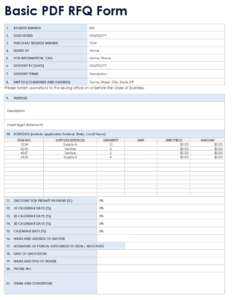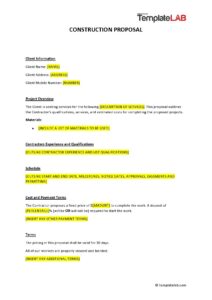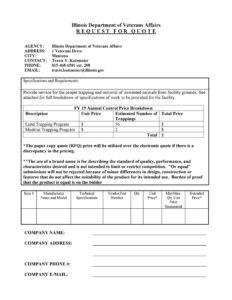Utilizing pre-defined formats for soliciting bids offers numerous advantages. These include reduced administrative burden through consistent documentation, minimized ambiguity in communications with potential suppliers, and increased efficiency in comparing offers. Furthermore, a structured approach fosters a level playing field for businesses of all sizes, encouraging broader participation and potentially leading to more competitive pricing and innovative solutions for the public sector.
This article will further explore key aspects of structured procurement processes within government, covering topics such as legal requirements, best practices for creating and using these forms, and common pitfalls to avoid. It will also examine the role of technology in streamlining these crucial administrative functions.
Key Components of a Government Request for Quote
Well-defined requests for quotes (RFQs) are crucial for efficient government procurement. Clear and comprehensive documentation ensures fair competition and facilitates informed decision-making. The following components are typically essential:
1. Project Title and Description: A concise and informative title, coupled with a detailed description of the required goods or services, sets the foundation for a successful RFQ process.
2. Solicitation Number: A unique identifier assigned to the RFQ allows for efficient tracking and management of the procurement process.
3. Issuing Agency Information: Contact details and relevant information about the government entity issuing the RFQ ensure clear communication channels for vendors.
4. Submission Deadline: A clearly stated deadline for submitting quotes promotes timely responses and facilitates a structured evaluation process.
5. Specifications and Requirements: Detailed specifications, including quantity, quality standards, and performance expectations, ensure that vendors understand precisely what is required.
6. Terms and Conditions: Standard contractual terms and conditions governing the procurement process, including payment terms and dispute resolution mechanisms, should be clearly outlined.
7. Evaluation Criteria: Explicitly stating the criteria used to evaluate quotes, such as price, experience, and technical capabilities, ensures transparency and fairness.
8. Instructions for Submission: Clear instructions on how to submit quotes, including format requirements and submission methods, streamline the process for both vendors and the procuring entity.
A comprehensive RFQ, encompassing these key elements, promotes a competitive bidding environment, leading to cost-effective acquisition of goods and services for government entities. This structured approach facilitates informed decision-making based on transparent evaluation criteria, ultimately benefiting taxpayers.
How to Create a Government Request for Quote Template
Developing a standardized request for quote (RFQ) template streamlines procurement processes and ensures consistency in soliciting bids from vendors. A well-structured template facilitates clear communication of requirements and enables efficient evaluation of responses. The following steps outline the process of creating an effective government RFQ template.
1: Define the Scope: Clearly outline the specific goods or services required. Detailed specifications, including quantity, quality standards, and performance expectations, are essential.
2: Establish Evaluation Criteria: Determine the factors that will be used to assess vendor responses. These criteria might include price, experience, technical capabilities, and past performance.
3: Develop Standard Content: Create boilerplate language for sections such as terms and conditions, instructions for submission, and agency contact information. This ensures consistency across all RFQs.
4: Incorporate Legal Requirements: Ensure compliance with relevant regulations and legal mandates governing government procurement. This includes provisions related to equal opportunity and ethical considerations.
5: Design a User-Friendly Format: Structure the template logically and clearly to facilitate easy completion by both the procuring entity and vendors. Use headings, subheadings, and tables to enhance readability.
6: Implement Version Control: Establish a system for managing template revisions and updates. This ensures that all stakeholders are using the most current version.
7: Seek Stakeholder Input: Gather feedback from relevant parties, including procurement staff and potential vendors, to refine the template and ensure its practicality.
8: Regularly Review and Update: Periodically review and update the template to reflect changes in regulations, best practices, and organizational needs. This ensures continued effectiveness and compliance.
A well-designed template, incorporating these elements, contributes significantly to transparent and efficient procurement practices. Standardized documentation ensures fair competition, facilitates informed decision-making, and ultimately leads to cost-effective acquisition of goods and services for government entities.
Standardized forms for soliciting quotes from vendors are critical for transparent and efficient public procurement. These structured documents ensure clarity, fairness, and accountability in government spending. Adherence to established procedures, coupled with well-defined requirements and evaluation criteria, fosters a competitive bidding environment, leading to cost-effective acquisition of goods and services. Furthermore, utilizing established templates reduces administrative burden and streamlines the evaluation process, allowing public sector entities to focus on strategic priorities.
Effective management of public funds requires diligent adherence to established procurement practices. Continued refinement of these processes, including the utilization of robust templates and adherence to best practices, is essential for responsible stewardship of taxpayer dollars. Ultimately, a commitment to transparent and competitive procurement contributes to public trust and ensures optimal value for public investments.


